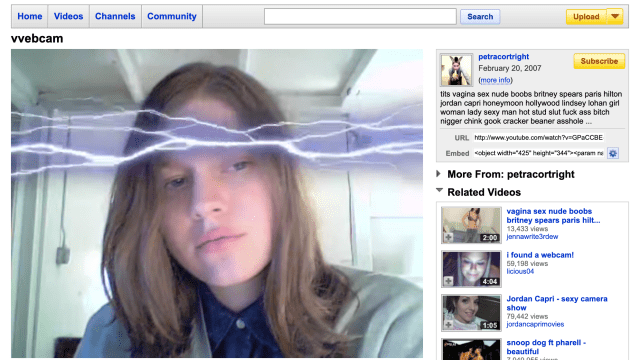The covid-19 museum closures have made abundantly clear that accession committees and the web’s corporate overlords don’t have much love for net art. While museums spent the past decade and hundreds of millions of dollars colonising the earth and sky to make space for hoards of painting and sculpture, the web’s billboard-plastered renovations have threatened to steamroll it into oblivion. (Nowhere is this more obvious than Google’s Arts & Culture, an online repository for work from 2,000 museums and collections, whose media include “vitreous enamel,” but not “video”–much less “HTML” or “gifs.”)
They’ve put their collections online, but a png of a Mexican mural stimulates about as much as a postage stamp; we need art that comes alive on browsers, and you’re going to have to do a little off-roading into the diaspora of blogs, strange domains, and obscure YouTube channels, to find it. While scanning the web for online artworks for socially-distanced consumption, Gizmodo wondered: how did net artists find net art? Which work led them to fire up their terminals and Photoshop canvases and build out this fragile universe for the public? This week, we’ll be sharing picks from the community of art-makers and caretakers who’ve created and preserved net art for the world, free of charge.
“I’m Famous Now!”
Famous New Media Artist Jeremy Bailey is the kind of attention hog only the internet has wrought. In a 2015 video, he postures in front of the camera, camgirl-style, opening with “hi there, cutie!,” while modelling augmented reality wearables like stock tickers on his nipples so that his subscribers could consume the internet without taking their eyes off of him. At the time he developed the persona (before and after Snapchat filters were a thing), F.N.M.A. Bailey hilariously spoofed the web’s narcissism and AR fetish, predicting that we’d all be living in a kind of rolling interface that was obviously absurd beyond reason. Women would wear digital masks, like a leering, bulgy-eyed unicorn face-covering he made for his wife so that she could always stay beautiful when “the ravages of time catch up to her.”
Now, in 2020, I look at the work and think: how did he know?
Actual artist Jeremy Bailey is a lot humbler than that persona, whose cheeky reference to “new media” plays on the awkwardness of a term that institutions were using for lack of a better phrase to describe artists experimenting with software. Bailey had been making video works since the early aughts but didn’t do much to explore the world of “new media” until he came across Petra Cortright, a deadpan idol of aughts net art, and her 2007 YouTube video “VVEBCAM.” Cortright looks utterly disinterested as flowers and cats dance across the frame, and published the video with keywords designed to attract users looking for offensive or sexual content and antagonized commenters, in the parlance of the times, writing, “syuck my dick sk8r fag.” (Rhizome has preserved a version with original comments and interface.) It might seem mundane to younger viewers now, but Bailey described how it paved the way and introduced him to a generation of creators like Jon Satrom and Constant Dullaart.
Bailey told Gizmodo about that formative experience:
I wouldn’t even have known that “net art” was a term when I started because I come from a video art background. The type of work that I was making [in the early aughts] was about thinking of the computer as a video camera, more in the history of video art that came out of the 1970s. Internet video was not a thing. Until suddenly, it was a thing.
One of my videos became really popular [‘World’s Strongest Man,’ 2003, in which he holds the camera perpendicular to his body as long as his muscles allow]. I couldn’t afford to keep it on my website because it was really expensive to host your own videos back then, so the university hosted it. It was my first experience with internet fame and probably my last, ironically, given my moniker. But I would travel around, and people would recognise me from that video. It was a 15-minutes-of-fame kind of thing. After that, I got the impression that video might be a big thing on the internet, and this platform called YouTube came along.
One of the first artists I found on YouTube was Petra Cortright, probably through [the New Museum’s digital arm] Rhizome–specifically her video ‘VVEBCAM.’ [It was] just different filters running across the screen. I was primed for this. I think people who watch it today, maybe Gen Y or Z, might wonder why is this exciting? She just has a deadpan look and is scrolling through these webcam filters that are not advanced by our modern-day standards: bunny rabbits and pizzas imposed in front of her on the screen. But I found it super exciting because she was being kind of smart with what software meant to the camera, to my point about the computer becoming the camera.
She even played with the keywords on YouTube and used the whole interface as part of the performance context, which was very unique, and it opened my eyes to the fact that YouTube could be a context for making work in general.
She was also smart about the type of videos that were made very early on YouTube, these kind of selfie versions of video that I ended up satirizing. These quirky, weird personalities that are now standard to YouTube were emerging right away—‘I’m famous now!,’ basically.
Petra’s work was the first video that was really pushing back against that in a banal way, but back when banality was really exciting. She had this bored look on her face, she did not marvel at the technology that sat in front of her, these stupid pizza filters made possible by fifty years of the military-industrial complex. It was just a really funny moment in the history of human expression.
